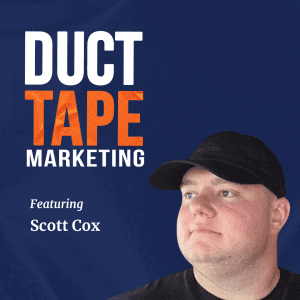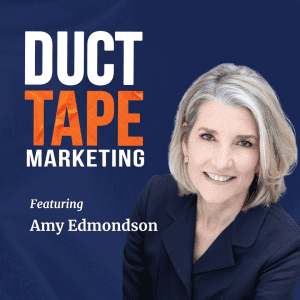Inside Out: Unlearning it all and Building Leadership from Within written by Tosin Jerugba read more at Duct Tape Marketing
The Duct Tape Marketing Podcast with John Jantsch
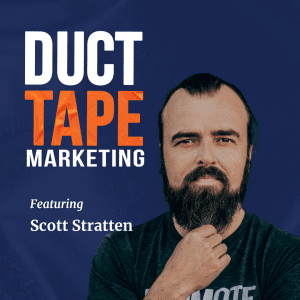 In this episode of the Duct Tape Marketing Podcast, I interviewed Scott Stratten. President of UnMarketing. Scott Stratten has Co-Authored 6 best-selling business books with his business partner and wife Alison and was formerly a music industry marketer, National Sales Training Manager, and a College Professor. They ran one of the most successful viral video agencies in the world for nearly a decade before solely focusing on speaking at events for companies like Walmart, Pepsi, Adobe, IBM, Microsoft, Cirque du Soleil and Saks Fifth Avenue when they need help navigating their way through the landscape of business disruption. UnLeadership: Make Building Relationships Your Business.
In this episode of the Duct Tape Marketing Podcast, I interviewed Scott Stratten. President of UnMarketing. Scott Stratten has Co-Authored 6 best-selling business books with his business partner and wife Alison and was formerly a music industry marketer, National Sales Training Manager, and a College Professor. They ran one of the most successful viral video agencies in the world for nearly a decade before solely focusing on speaking at events for companies like Walmart, Pepsi, Adobe, IBM, Microsoft, Cirque du Soleil and Saks Fifth Avenue when they need help navigating their way through the landscape of business disruption. UnLeadership: Make Building Relationships Your Business.
Key Takeaways
In this riveting episode Scott Stratten discusses the concept of Unleadership. A sequel to their practical and effective ideas on Unmarketing. Drawing from their four-page chapters book, Scott compares leadership to culture as it continues to be made of the unseen “everyday stuff”, as opposed to what you can make a picture out of such as: a person addressing a team of individuals.
Beginning with a dose of self-awareness and the fact that “you don’t know what it’s like to work for you”. Scott challenges leaders to define what a ‘job’ really is and to question what they consider ‘insurbordination’ in the workplace, touching on the other side of the coin: the overused, misused phrase ‘we are a family’ when referring to the business, and many other overlooked yet relatable pointers in building professional and empathetic subordinate relationships required to achieve set company goals and build a culture that is understood even at the very top of the organisational structure.
Questions I ask Scott Stratten:
[01:59] When is the aptly named revised edition of ‘QR codes, kill kittens’ coming out?
[06:16] What is unleadership?
[07:26] Would you say that most leaders need to unlearn what they’ve been taught?
[15:18] Talk about how leadership is a creative act?
[16:26] How do we draw the line between the family concept of the workplace and being cordial?
[20:16] Do you have a story that sets a great leadership example of somebody you profile?
[22:23] Where can people connect with you?
More About Scott Stratten:
Like this show? Click on over and give us a review on iTunes, please!
Connect with John Jantsch on LinkedIn
This episode of The Duct Tape Marketing Podcast is brought to you by ActiveCampaign
Try ActiveCampaign free for 14 days with our special offer. Sign up for a 15% discount on annual plans until Mar 31,2024. Exclusive to new customers—upgrade and grow your business with ActiveCampaign today!
Testimonial (00:00): I was like, I found it. I found it. This is what I’ve been looking for. I can honestly say it has genuinely changed the way I run my business. It’s changed the results that I’m seeing. It’s changed my engagement with clients. It’s changed my engagement with the team. I couldn’t be happier. Honestly. It’s the best investment I ever
John (00:16): Made. What you just heard was a testimonial from a recent graduate of the Duct Tape Marketing certification intensive program for fractional CMOs marketing agencies and consultants just like them. You could choose our system to move from vendor to trusted advisor, attract only ideal clients, and confidently present your strategies to build monthly recurring revenue. Visit DTM world slash scale to book your free advisory call and learn more. It’s time to transform your approach. Book your call today, DTM world slash scale.
(01:03): Hello and welcome to another episode of the Duct Tape Marketing Podcast. This is John Jantsch. My guest today is Scott Stratten. He’s the president of UnMarketing. His co-authored six bestselling business books with his business partner and wife Allison, and was formerly a music industry marketer, national sales training manager and a college professor. If we could just add NBA started, it would be amazing.
Scott (01:29): It just
John (01:29): All how professional speaker for companies like Walmart, Pepsi, Adobe, IBM, Microsoft, and the list goes on. But today we are going to talk about his book, leadership Making, make Building Relationships Your Business. So welcome, Scott.
Scott (01:46): John. If it wasn’t for my height, my endurance, my strength, my shooting ability, my defending ability and rebounding, I would be in the NBA. Thank you for having me on, John. It’s wonderful to see you again
John (01:56): As with all of us.
Scott (01:57): Exactly, exactly.
John (01:58): Here’s what I really want to know. When is the revised edition of QR codes kill kittens coming out?
Scott (02:05): The best part. The best. I know it’s a joke, but the best part about that is when you write a book called QR Codes Kill Kittens, which is a business picture book of business screw ups. When a New York Times reporter during a pandemic, Googles QR codes because they’re doing a story on how crazy they’ve been. Whose name do you think comes up first for them? Every single time I got into New York Times twice, including I have it right here beside me for my mom, an edition of the New York Times just because of that. So it’s like if it didn’t bring me anything and people were every single, I swear John, every time it came up in the news somebody, people would forward it to me. What do you think now? What do you think now? And I’m like, it only took a pandemic. And for Apple to make the iPhones have it natively in the camera. That’s all. That’s all. Congrats. Save the kittens.
John (02:55): Yeah, but they still don’t belong on Billboards on the Highway
Scott (02:58): Though. But they still don’t belong a billboard. They still don’t belong in an email. All the rules still apply. It hasn’t changed. Go back, look, go to the tape. You have me. My about it was a Whataburger conference and I had told them, I said there, I’m like in a closed system, great boarding pass killer concert ticket. Awesome. You walking around in public, not as easy to do. If you’ve ever seen a human being, it just, it doesn’t always work. So yeah, so congrats. The QR codes, they’re the true winner of the pandemic.
John (03:26): That’s right, that’s right. Good point. So one of the things I like about this book is that the chapters are all really short. There are 70 like four page chapters, and I get excited when I finish a chapter.
Scott (03:40): One of the great things with, I’m such a lucky human because Allison is a brilliant writer and I run after squirrels. I just run around and there is a reason why I got so big on Twitter, right? That’s about my length of my focus of time that I can write things for. And so when originally marketing was doing, I was writing it in the way that I thought, which was very short, great chapters. And Allison just ran that with the baton. And when we got to on leadership, one of the really key things, and the reason why there’s 70 smaller chapters in it is because if Allison, and I believe that one of the most important parts of leadership is self-awareness. Meaning knowing what you can and can’t do and knowing your people as well and how you affect them. That we can’t talk about leadership because Allison and I are blessed with the fact that we don’t go into work, that we don’t have a boss, that we don’t have a corporation and we don’t have, it’s easy for me to get on stage and say, just do this and then I get to go home.
(04:38): But for us, we wanted to say, look, if self-awareness was the key, we have to be self-aware. And so we found, we looked up and we just figured out over an extended period of time, as you’re getting a book together, you just ideas start popping and popping. And we came up with 53 UN leaders that we had learned from and either gotten to know or knew from afar over the past 15, 20 years and decided Allison interviewed every single one of them for an hour, boiled all their thoughts down to about 1100 words each and put it and put it all together. And it’s the most diverse group of industries, of levels and of human beings that we think we could find for it. And the best red thread as our Fred Damson would say the best through all of it was almost every single person in the book questioned why they were being asked to be in the book.
(05:29): They didn’t think they were, why would you ask me to be in a leadership book? And the answer was, because you’re asking why? Because you’re not doing these things to be in a leadership book. You’re not doing these things to go trend virally on Instagram or something like that, or LinkedIn or something like that that we got to. It’s one of the wonderful things, not about social media, but being an author and being in this world where we get to go and I get to see so many companies when I go through and talk to so many people and certain things just kind of bubble up to the surface and then we get to go and say, look, here’s our favorite 53 people in leadership. And it is such a joy.
John (06:10): Yeah, that’s amazing. So I guess maybe we better let you define it Al Bite, what is UN leadership?
Scott (06:18): I think leadership is really, it goes with all of our other uns, the unselling, unbranding and on marketing stuff, which is leadership is moments. It’s not in the time where leadership is not a performance review, leadership is not an all hands meeting and you get up and talk to the team, leadership is made up of everyday things because we understand that it’s like the word culture. Okay, and well, what is that? Well, it’s very simple. It’s how the person at the bottom of the org chart feels. Culture is driven top down and felt bottom up. I just did it last week. I was in front of a bunch of leaders in a room and I looked at him, I said, none of the actual culture of your company because you have power. And the culture is felt by that bottom rung. And that’s where leadership is, people looking at the people below them as their inspiration versus the people above them. That’s really what it comes down to me.
John (07:10): So a theme of really all of your books is to somewhat say what we commonly take as marketing or as selling or as leadership maybe is wrong. And that there is, here we go, pun unlearning that we have to do. I mean, would you say that’s true that most leaders or many leaders need to unlearn what they’ve been taught?
Scott (07:31): I think really it really comes, yeah, I think people individually, because the reason why I say people is because you can’t try to figure out or shift or change as a leader and not as a person. So if self-awareness is really huge, and I beg of people to hear that, that self-awareness is such a huge key to not now going forward, but also in the world that I don’t think you put on your professional persona and you can be self-aware and you then take it off and you’re not. And I think one of the things is realizing that we are part of the situation. It’s like saying for me, example, every single relationship that I broke up with somebody, every broken relationship I’ve had in my life, and there’s been many, I’m the only common denominator in those. It was never my fault, but I’m the only common denominator.
(08:25): So starting to realize those things and if you wanted to have a different relationship, maybe look at yourself too. I’ll give you an example of that even though this is right down the personal side of the road, but it’s like the phrase, you ever heard that that phrase John, that old phrase, right? Do you want to be right or do you want to be happy? They usually say that line about marriage, and I’d always hear that and I’m like, yeah, that’s a good point, right? What I never thought, what I never thought was there was a third option, I be wrong, possibly wrong. Not just are you right or you’re happy, but maybe also looking at what you could be wrong. And that was never part of that equation. That was never part of that answer. It’s right or happy. No, maybe to submits you’re wrong sometimes.
(09:09): And it’s a fascinating thing in leadership that we don’t take that look at a company, look at a company with let’s say five levels, c, EO, and then we have vp, director, manager. Then the bottom of the org chart, what you drive down is the weight gets heavier and heavier as it goes down. And if you want to know how things are going, do you want to know how to be more efficient? Do you want to know how to hold onto your people they know? They all know The problem is anytime we go against what the upstream is saying, we call it insubordination, except the only way to innovation is through insubordination. Think of every company that’s ever innovated it usually broke into or took away or threatened an existing piece of business or existing way of doing something. But that insubordination, and I want you to hear this, anybody listening right now who is in a leadership position, I don’t care how high up or how down low you are, if anybody reports to you, if that individual is talking to you and you feel they’re being insubordinate, meaning they’re disagreeing with you, which is not insubordinate by the way, but they’re disagreeing with you, giving you feedback and saying, I don’t think this is going to work.
(10:14): Do you understand the risk they’re taking, that they are risking potentially their job or their future placement in the company or their relationship with you to drive this home? That’s how important this point is to them. So instead of trying to think of why I’m right or why this person shouldn’t be saying this or they were told something, we hire people so we can use their brains on top of whatever else they’re doing. And you want to keep people listen to them. You want to keep people ask for their feedback. You can use something simple star, continue the most basic thing that a bunch of people have used in the past. What should we stop doing? What should we start doing? What should we continue doing? But we don’t. You don’t know what it’s like to work for you. I put that on the screen on stage and I let it sit there for about 10 seconds. It’s the juiciest 10 seconds of my day because it makes people just shift a bit in their chair. And then I say to them, this can’t be about you personally because I don’t know you, but if you’re getting a little uncomfortable reading this, take note.
John (11:16): It’s my pleasure to welcome a new sponsor to the podcast. Our friends at ActiveCampaign. ActiveCampaign helps small teams power big businesses with the must have platform for intelligent marketing automation. We’ve been using ActiveCampaign for years here at Duct Tape Marketing to power our subscription forms, email newsletters and sales funnel drip campaigns. ActiveCampaign is that rare platform that’s affordable, easy to use and capable of handling even the most complex marketing automation needs. And they make it easy to switch. They provide every new customer with one-on-one personal training and free migrations from your current marketing automation or email marketing provider. You can try ActiveCampaign for free for 14 days and there’s no credit card required. Just visit activecampaign.com/duct tape. That’s right. Duct Tape Marketing podcast listeners who sign up via that link. We’ll also receive 15% off an annual plan if purchased by March 31st, 2024. That’s activecampaign.com/duct tape. Now, this offer is limited to new active campaign customers only. So what are you waiting for? Fuel your growth, boost revenue and save precious time by upgrading to active campaign today. As a side note here, as a speaker, it’s probably was hard to hold on to something for 10 seconds of silence, isn’t it?
Scott (12:42): And it feels like 10 minutes. It’s so great because part of that’s for me is that’s my job. That’s what I do. So doing that type of timing something is really important on impact because also you get on stage and I’m not getting up there saying everybody’s a terrible leader. What I’m saying is we have to shake the entire foundation to say, Hey, because there’s a lot of people right now that are trying to go back to four and a half years ago. There’s a lot of people right now saying, let’s just go back to normal, back to business. And you’re missing the plot, you’re missing everything. People are not going back. Things have shifted. It was the great, we called the bluff. We had resistance to working from home for 20 years. And you know why I say 20 years? Because I asked over 20 years ago to telecommute because we called it telecommuting at the time when my son was about to be born and I traveled to train our distributors in sales and they said, no, we’re not a company that does that.
(13:43): They were also not a company that we were on the internet for a long time. And you look at this stuff and people were just like, I can use that example. And one of the problems, John, is get asked to speak somewhere. They’re like, can you talk to our audience about retaining people nowadays in a younger generation and attracting younger generation, but just don’t bring up two things. Don’t bring up pay and don’t bring up return to office. And I’m like, so the two main things, the two main things, right? It’s like there was a great phrase I saw somebody was speaking at a Davos or something. It’s like having a firefighter convention and not being allowed to talk about water. It’s literally those things. They’re your biggest things or you’re like, Hey, well why don’t we put something on, how do we attract younger people to our industry?
(14:25): And somebody pipes up an intern’s like, why don’t we do something on TikTok? And you’re like, shut up. We don’t do that here. We don’t do that type of stuff. And you’re just like, what are you talking about? What are you talking about? I’m really hoping, I’m trying to get us back to the point of understanding what a job is. A job, somebody working for you is a business agreement. It’s a contractual agreement. I offer you my skills and my intellect. You give me a job description that I’m supposed to follow, including other duties as noted, which is the worst one of the whole job description. And in exchange you give me a compensation package, but we’ve thrown that somehow. It’s just like you work here, you do what I say and you’ll like it. And I’m done with that. And so many people are too. One
John (15:12): Of the early chapters, I think it’s chapter three, chapter four, I don’t have the table here, but you essentially talk about leadership being a creative action or creative act. And I think that is something that so many people miss.
Scott (15:25): You cut out when you said the exact point I was going to talk about, can you repeat it?
John (15:30): The title is, the idea of the chapter is that leadership is a creative act. And that I think that’s a brilliant idea that so many people miss because they think they’re not creative.
Scott (15:42): Well, and that’s part of the point too, right? It’s like when you’re coming together, look, the subtitle is Make building relationships your business. It’s literally about relationship. And when you come together in relationship, the sum of what creates out of that is supposed to be something you can’t do yourself. A leader’s supposed to be able to tap into their people and stuff they didn’t think they had or think that they can come out with. It’s a great one. Jeff Alexander is in one of the chapters, he talks about partnerships even where you’re going into a partnership where you’re supposed to be looking at the other side first when you’re leading, you’re supposed to be what do they need? What do they need versus this is what I’m trying to get out of something. And it’s that same thing as a leadership subordinate relationship as well.
John (16:27): So relationships, connection, group hugs. How do we not make this family? Because I don’t believe it’s a family. I have a family. It’s not
Scott (16:38): Like my business. I agree. I agree with you.
John (16:41): How is this a fine line between when I hear relationship connection, do I start to leap to like, oh, this is a personal thing?
Scott (16:49): Yeah. Well, and that’s the thing. Okay, so there’s a couple of things. So it’s funny is the group that is most against relationships, marketing and connection and leadership are the ones that call their businesses a family. Because what they mean by that is you don’t say anything negative. You don’t bring anything up. You don’t go outside of the house. You don’t go outside. Look, and like you said, I don’t need another one. Allison and I combined have five kids. You can take your own family and do what you need to, but we’re covered here. Okay, we’re covered here. And I’m not rolling the dice again. We got five great ones. I’m not going again for anybody else coming into this. I know the odds. But there’s this thing that the problem is, it’s always the context, right? Because I’ve talked to people privately about it.
(17:31): I brought it up and I said, don’t say we’re a family here it, it’s not good. And nobody, so many people in leadership donors, because they’re the ones saying it and their intent is supposed to be good. But I really want people to go back down to let’s go to, depending on where you’re in school, it could be grade 12 or it could be maybe college. There’s the basic communication model. You just pull that out of a textbook. There’s sender and receiver, and the sender encodes the message they’re going to send and they send it to you. And then in between you there’s noise and then the receiver decodes it and takes it the way they take it. Well, that type of stuff. When you look at somebody who’s about to work here and say, we’re family, you mean one thing, they hear another. It’s just a bad way to put it, first of all.
(18:16): But I really break it down to somebody and say, what do you mean by you mean that you have each other’s back then that is not, we’re a strong team. It’s our wording. Okay, family is, I’m going to feel like I’m going to show up at Thanksgiving. I have to deal with that cousin again. I don’t have to want to see him. I got to see him twice a year. Right? Look, and people use these phrases and stuff too, and we throw them out in leadership without even knowing the context of that. Like the family phrase, blood is thicker than water. You hear that phrase? That’s an old time. And that’s not the saying it’s blood of the covenant is thicker than water of the womb. It’s actually the opposite of what the phrase means. That created connections can be stronger and better than family connections.
(18:59): It’s actually contradicting what you’re trying to do. And that’s where it creeps me out as well. But relationships aren’t about that. Relationship is simply, you are connected to the other person and you understand them. That’s what relationship is to me. A personal relationship is a whole other thing. I don’t think that you should have to do anything outside of the office for your job. I don’t think you should lose anything because of that. I think that I do my job and I do it well. The problem is people’s definition of, well, a team player comes out for drinks, A team player comes on, does this type of thing, going to chip in for the boss. We’re getting a gift for the boss. Jurgen chip ins, by the way, stop that. Money flows down, not out. There’s no bosses. You don’t buy bosses day stuff. Fundraising is inappropriate to do in the office when it’s directly threatened to somebody saying walk into their cubicle and say, are you going to fundraise? These type of things, no, because they’re like, well, this is professional. You’re not professional. So much of what we say and do is not in these workplaces, but they say, well, we’re this, no, it’s rules for the and not for me a lot of times when it comes to these things.
John (20:08): So you mentioned, and I know this is going to be hard for you, I’m going to do it anyway, there were 53 people you interviewed. Do you have a favorite story? It doesn’t have to be a favorite story. Do you have a story you like to tell as a leadership, a great leadership example of somebody you profiled?
Scott (20:22): Dr. Derek Kayongo. He is one of my favorite people on the planet, and for a few reasons. One, he’s the best dresser I’ve ever seen in my life. He’s the coolest person I’ve ever met in my life. But beyond that, he’s the most genuine, caring person. One of the people I’ve met in my life, Derek, one of the things he noticed when he came over to America when he was stayed at hotels was that they were throwing away the soap. And he came from a country that, well, they didn’t have a lot of soap, and that would be really fricking cool if all the Soapies would throw out would go over to where I’m from. And he created an entire organization and got the entire entire country to get their soap all sent back. And they had a whole thing and disinfected it. And he created an entire soap company, saw a problem.
(21:13): I have a man bun and Derek changed the world in soap. So it’s like I spoke after him at an event and he got up there and then it was like the Kelly Brothers were the day before. So two astronauts, Derek Kayongo, man, who changed the world with soap. And then I walked on stage. I really got to plan these things better because to the moon, saving the world. And I’m just like, man bun. That’s what I do. I love ’em. But honestly, John, to give you now the cop out answer after that, literally just feed through it and then pick one. That’s Aaron Bur Aaron I knew from Twitter in oh nine, we were all Toronto Twitter people. She ended up creating willful because she noticed that Wills were very cumbersome, very kind of expensive. You had to go through lawyers. She’s like, it makes no sense. So she created Willful. Willful is online Wills in Canada. She went and worked with every province, every law board, everything else. And now she’s got a wonderful company that gives a damn. And I got to watch her build it on LinkedIn all through her posts because she wanted to change the way things were done. And that’s one of my favorite parts of people and of startups and of founders that said, it’s one of my favorite parts about disruption is customers who get so pissed off, they create the alternative. And that’s what she did.
John (22:28): I love that too. Well, Scott, it was awesome catching up with you, having you stop by the Duct Tape Marketing Podcast anywhere you want to invite people to connect with you or find obviously a copy of UN Leadership.
Scott (22:40): Yeah, UN Leadership Available wherever good books are sold. And yeah, we’re at unmarketing.com. Come by, say hi, LinkedIn, Instagram, whatever you want, and just enjoy the book.
John (22:51): If I reach out to you on LinkedIn, do you want me to unfollow you? Is that
Scott (22:55): Yeah. Oh yeah. It’s my last place. I think. I’m like, I’m gone off Twitter. I’m gone off Facebook, but LinkedIn is holding on, so I’m still there for the time being. So hurry up. Awesome.
John (23:03): Alright. All right. Again, thanks for stopping. Bye. Hopefully we’ll run into you one of these days out there on the road.
Sign up to receive email updates
Enter your name and email address below and I’ll send you periodic updates about the podcast.
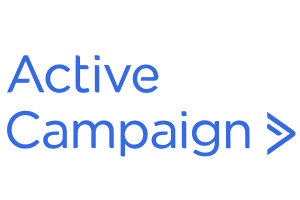
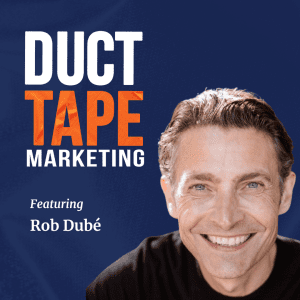
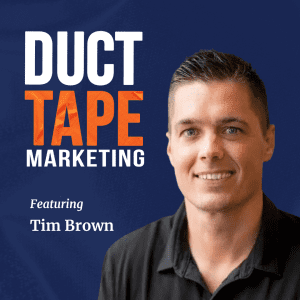 In this episode of the Duct Tape Marketing Podcast, I interviewed Tim Brown, founder of Hook Agency, a leading SEO and web design firm specializing in home service businesses such as roofing companies, HVAC, and plumbing services. Tim shares his expertise on the ever-evolving world of SEO, shedding light on the crucial components that contribute to successful online visibility and rankings.
In this episode of the Duct Tape Marketing Podcast, I interviewed Tim Brown, founder of Hook Agency, a leading SEO and web design firm specializing in home service businesses such as roofing companies, HVAC, and plumbing services. Tim shares his expertise on the ever-evolving world of SEO, shedding light on the crucial components that contribute to successful online visibility and rankings.

